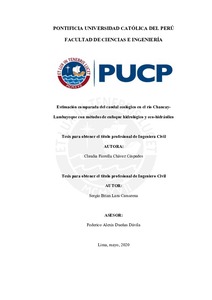| dc.contributor.advisor | Dueñas Dávila, Federico Alexis | |
| dc.contributor.author | Chávez Céspedes, Claudia Fiorella | |
| dc.contributor.author | Lara Camarena, Sergio Brian | |
| dc.date.accessioned | 2020-08-17T20:11:04Z | |
| dc.date.available | 2020-08-17T20:11:04Z | |
| dc.date.created | 2020 | |
| dc.date.issued | 2020-08-17 | |
| dc.identifier.uri | http://hdl.handle.net/20.500.12404/16831 | |
| dc.description.abstract | El caudal ecológico es un término que surgió como una solución a la posible pérdida del recurso hídrico debido a su explotación desmedida por la sociedad. En la actualidad, este concepto ha evolucionado hasta considerarse una herramienta para mitigar los impactos ecológicos que ocasionan la alteración de los regímenes naturales de los cuerpos de agua. Por ello, se pretende que todos los ríos posean la cantidad y calidad de agua necesaria para preservar a los sistemas acuáticos dependientes.
En el Perú, la cuenca del río Chancay – Lambayeque es considerada una de las más importantes debido a su alto caudal, que permite almacenar sus aguas en el reservorio Tinajones para luego derivarlas a diversos poblados, como son Chiclayo y Lambayeque, para uso poblacional y de regadío (Pact Perú, 2013). Estas actividades son una fuente económica de altos ingresos para el país; sin embargo, la variación de las características hidrológicas del río entre la bocatoma y la sección de restitución del caudal, generan efectos negativos en los ecosistemas marinos, los cuales amenazan el desarrollo de especies. | es_ES |
| dc.description.abstract | The ecological flow is a term that emerged as a solution to the possible loss of water resources due to its excessive exploitation by society. Nowadays, this concept has evolved until it got considered as a tool to mitigate ecological impacts, caused by the alterations of water bodies’ natural regimes.
In Perú, the basin of the river Chancay-Lambayeque is considered to be one of the most important of the country because of its high flow, which allows it to store its water in the Tinajones reservoir and then divert them to various towns, such as Chiclayo and Lambayeque, for population and irrigation use (Pact Perú, 2013). These activities are a high-income economic source; however, the variation of the hydrological characteristics of the river between the intake and the flow restitution sections, generate negative effects on marine ecosystems which threaten the development of species. | es_ES |
| dc.language.iso | spa | es_ES |
| dc.publisher | Pontificia Universidad Católica del Perú | es_ES |
| dc.rights | info:eu-repo/semantics/openAccess | es_ES |
| dc.rights.uri | http://creativecommons.org/licenses/by-nc/2.5/pe/ | * |
| dc.subject | Ingeniería hidráulica--Módelos hidráulicos | es_ES |
| dc.subject | Recursos hídricos--Impacto ambiental--Perú | es_ES |
| dc.subject | Ecohidrología--Perú | es_ES |
| dc.title | Estimación comparada del caudal ecológico en el río Chancay- Lambayeque con métodos de enfoque hidrológico y eco-hidráulico | es_ES |
| dc.type | info:eu-repo/semantics/bachelorThesis | es_ES |
| thesis.degree.name | Ingeniero Civil | es_ES |
| thesis.degree.level | Título Profesional | es_ES |
| thesis.degree.grantor | Pontificia Universidad Católica del Perú. Facultad de Ciencias e Ingeniería | es_ES |
| thesis.degree.discipline | Ingeniería Civil | es_ES |
| renati.advisor.dni | 23860033 | |
| renati.advisor.orcid | https://orcid.org/0000-0002-6149-3334 | es_ES |
| renati.discipline | 732016 | es_ES |
| renati.level | https://purl.org/pe-repo/renati/level#tituloProfesional | es_ES |
| renati.type | https://purl.org/pe-repo/renati/type#tesis | es_ES |
| dc.publisher.country | PE | es_ES |
| dc.subject.ocde | https://purl.org/pe-repo/ocde/ford#2.01.01 | es_ES |






